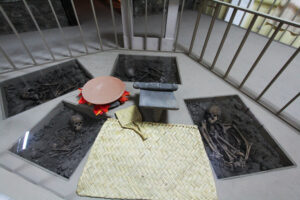Engaged Anthropology Grant: Lisa Overholtzer

Dr. Lisa Overholtzer is Assistant Professor in the Anthropology Department at Wichita State University. In 2009, as a doctoral student at Northwestern University, she received a Dissertation Fieldwork Grant to aid research on ‘Household Spaces and Everyday Practices at Postclassic Xaltocan, Mexico,’ supervised by Dr. Elizabeth M. Brumfiel. In 2013, she was awarded the Engaged Anthropology Grant to return to her fieldsite and share her research findings with the descendent community.
My Wenner-Gren funded dissertation research investigated the Aztec imperial transition from the perspective of commoner households at the site of Xaltocan, capital of the pre-Aztec Otomí city-state. While ethnohistoric documents suggested that all of Xaltocan’s residents fled when their polity was conquered, and that the Aztec king sent taxpayers to repopulate the site some forty years later, my excavations of commoner houses provided clear evidence of continuity. Houses were constructed and burials were interred in the same spaces from 1240 to 1650 C.E., and radiocarbon dates revealed no gap in occupation. This analysis allowed me to reveal the exercise of power by imperial elites, which involved the silencing of ordinary people and the rewriting of their histories. A bottom-up contextual analysis of multiple lines of evidence—household architecture, domestic refuse, human skeletal remains, and ancient mitochondrial DNA—then offered an alternative narrative based on the histories that commoners inscribed in the material record. My dissertation project took a bottom-up approach not only theoretically, but also in practice. In line with the recent paradigm shift within the discipline away from exclusivity and colonialist modes of research and toward inclusivity and socially self-conscious models of investigation, I engaged descendants through community archaeology. This process culminated in a team-wide public symposium at the end of the field season.

As part of my continued efforts to ensure that archaeological research benefits members of the descendant community, I returned with several students and colleagues in July 2013 to create a more permanent and more accessible mode of dissemination in the form of a new exhibit hall. This extension of the local museum was funded by a Wenner-Gren Engaged Anthropology grant, Wichita State University, the David and Sally Jackman Foundation, and the Lowell D. Holmes Museum of Anthropology. This project was designed to fulfill community needs by attracting tourists, educating the public about the town’s history and archaeological record, teaching visitors about the archaeological research process, and serving as a permanent interface between archaeologists and the descendant community in Xaltocan.

This exhibit hall, which opened in September 2013, presents narratives of Xaltocan history that are based not on the elite-authored and manipulated documentary record, but on the practices of the subordinated commoners who formed the backbone of the Aztec empire. The central feature of the exhibit is a Replica house, an authentically reconstructed adobe house featuring stone foundations and a thatched reed roof. The Xaltocan replica house brings ordinary people to life, but perhaps more importantly presents archaeological evidence of the occupational continuity revealed by archaeological research. We chose to reconstruct the house occupied precisely during the supposed vacant period in Xaltocan’s history, thereby highlighting the persistence and resilience of ancient Xaltocan families. Rather than presenting a history in which conquered residents had no other choice than to flee when their town was conquered in 1395 C.E., we narrate how Xaltocan families persevered, strategically adapting their daily practices according to their changing social, political, and economic context. We offer an alternative narrative that does justice to the practices of subordinated and silenced commoners in the past, thereby countering the exercise of imperial power.

Building the replica house was an experimental archaeology project involving collaboration with an adobe consultant and reed farmer and weaver brought in from the broader region. It also involved experimentation with materials used in ancient times, but not today, such as cactus juice employed as a mortar binder, as well as avoiding modern materials, such as animal manure added as a binder in adobe blocks, that would not have been available to pre-Hispanic builders. We also replicated the patio and house mound via a wooden platform and displayed the burials of household members in their place under the patio, visible through plexiglass windows. Finally, we furnished the house and patio with replicas of the kinds of objects residents would have had. A backstrap loom, baskets filled with dried foodstuffs, gourds, and sleeping mats were placed inside the house. The grinding stone and griddle women would have used to make tortillas every day were placed on the patio, on top of the graves of their loved ones, demonstrating how ancient residents lived with their dead. The exhibit hall was painted with colors and decorative motifs found on spindle whorls recovered in my excavations.

Together with text panels in Spanish and English, photographs, and exhibit cases filled with excavated artifacts, the replica house teaches visitors about the distinct line of evidence that archaeology can provide. The exhibits highlight how archaeologists date deposits, from stylistic seriation to stratigraphy to radiocarbon dating; analyze human bone and identify sex, age, occupational activities, and chronic illness; and reconstruct gender norms and household philosophies using the material record. The new exhibit hall teaches residents to see the archaeological record not as obstacles to construction, trinkets with monetary value, or simple curiosities, but rather as useful testimonies of the cultural practices of their ancestors. Through this museum and educational programs planned in the Xaltocan cultural center adjacent to the museum—such as summer youth classes on archaeology, Xaltocan history, and technical drawing—local residents can begin to see archaeological resources as sources of history, identity, and possibly future professional study.
